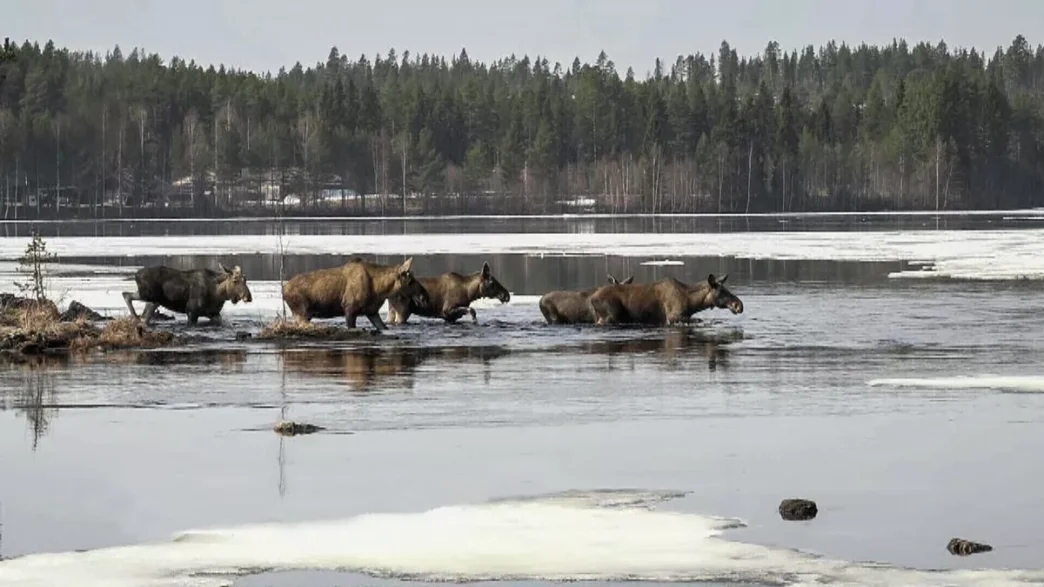Before the anticipated broadcast of Sweden’s slow TV sensation, “The Great Moose Migration,” Ulla Malmgren prepared by stocking up on coffee and ready-made meals. She planned to dedicate her full attention to the 20-day, round-the-clock event, determined not to miss any part of the annual spectacle. The program, known in Swedish as “Den stora älgvandringen” and sometimes referred to in English as “The Great Elk Trek,” first aired in 2019 and quickly gained popularity, capturing the attention of nearly a million viewers initially. By 2024, the audience grew significantly, drawing in 9 million viewers on the SVT Play platform, the streaming service of Sweden’s national broadcaster, SVT.
The livestream, which began earlier than scheduled due to warm weather and early moose movements, is set to continue until May 4. Remote cameras document the journey of dozens of moose as they cross the Ångerman River, approximately 300 kilometers northwest of Stockholm, in their seasonal migration toward summer grazing pastures. Although hours may pass without significant action, enthusiasts find a unique charm in the tranquility of the show. Among them is William Garp Liljefors, a 20-year-old collector of over 150 moose plush toys, who expressed a playful anxiety about missing a moose sighting even for a brief bathroom break.
“The Great Moose Migration” is part of a growing trend in slow TV programming that began in 2009 with the Norwegian broadcaster NRK’s broadcast of a seven-hour train ride across southern Norway. This style has since expanded globally, with similar productions appearing in the United Kingdom, China, and other countries. For example, Utrecht in the Netherlands has installed a “fish doorbell” on a river lock, allowing viewers to notify authorities about migrating fish. The appeal of slow TV lies in its authenticity and absence of staging, offering viewers a chance to unwind and experience the natural world at a leisurely pace. Annette Hill, a media and communications professor at Sweden’s Jönköping University, noted that the appeal stems from the serene beauty captured in real-time.
For the production team behind “The Great Moose Migration,” the calming effects extend beyond the audience. Johan Erhag, the project manager at SVT, mentioned that the crew experiences reduced stress levels while working on the show. The moose’s ancient migratory path enables the team to strategically position about 20,000 meters of cable, 26 remote cameras, and seven night cameras along the route. Additionally, a drone is employed to capture the event with minimal disturbance to the animals. While production costs remain undisclosed, Erhag emphasized that the cost is relatively low considering the extensive footage aired.
The moose, Sweden’s largest wild animals, are a source of national fascination. These majestic creatures, often referred to as the “King of the Forest,” can reach impressive sizes, with bull moose standing up to 210 centimeters tall at the shoulder and weighing as much as 450 kilograms. Despite their size, moose are typically elusive and solitary, making sightings a rare delight for many. The livestream provides viewers with an opportunity to observe these animals in their natural habitat, bringing a slice of nature into their homes.
Hanna Sandberg, who first tuned in during 2019, became captivated by the show after finally witnessing moose in action the following year. The experience offers viewers a unique perspective on wildlife, one that is otherwise inaccessible. As with many slow TV enthusiasts, there’s an undeniable thrill when a camera captures a moose approaching the riverbank. Alerts are sent through SVT’s app, prompting viewers worldwide to join in the excitement as the moose make their way across the water, cheered on by comments in the livestream’s chat.
Your World Now
The phenomenon of slow TV, exemplified by “The Great Moose Migration,” offers viewers a distinctive connection to nature from the comfort of their homes. This style of programming has the potential to reshape how people relax and unwind, providing a peaceful retreat from the demands of modern life. For individuals like Ulla Malmgren and William Garp Liljefors, the show offers a rare opportunity to witness the natural world in a way that is both calming and captivating.
Beyond personal entertainment, the trend of slow TV has broader implications for community engagement and environmental awareness. By bringing natural events into the living room, these programs foster a deeper appreciation for wildlife and ecosystems, potentially inspiring viewers to support conservation efforts. Additionally, the low-cost nature of such productions could encourage more broadcasters to explore similar content, expanding the genre’s reach and influence.
Overall, “The Great Moose Migration” is more than just a television show; it is a cultural event that resonates with audiences by tapping into a universal desire for tranquility and connection with nature. As the trend continues to grow, it may redefine how people engage with media, placing a greater emphasis on mindfulness and the simple pleasures of observing the world around us.














